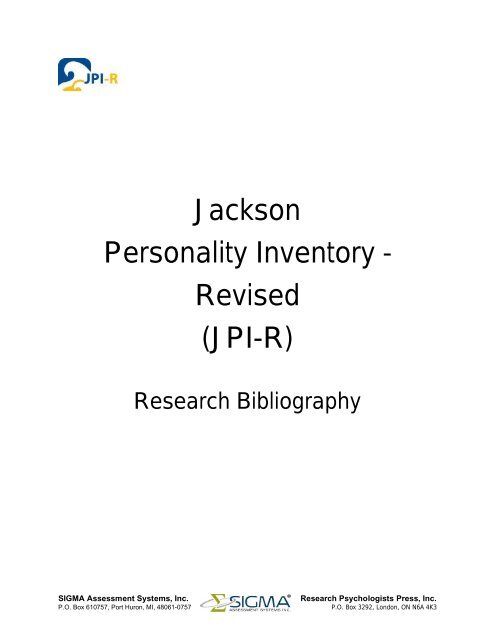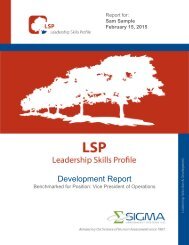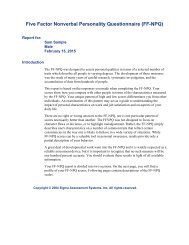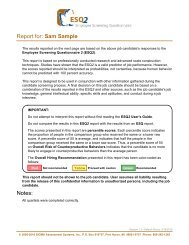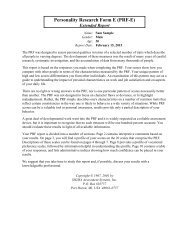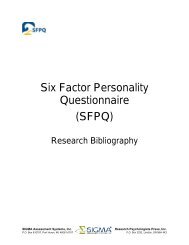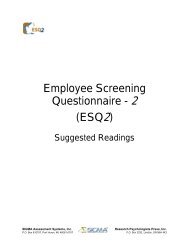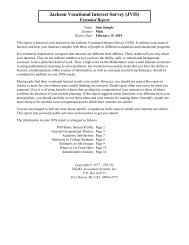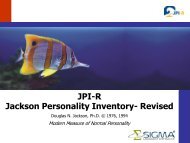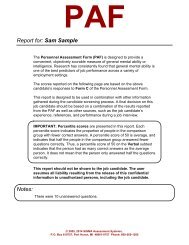Jackson Personality Inventory – Revised (JPI-R) - Sigma ...
Jackson Personality Inventory – Revised (JPI-R) - Sigma ...
Jackson Personality Inventory – Revised (JPI-R) - Sigma ...
Create successful ePaper yourself
Turn your PDF publications into a flip-book with our unique Google optimized e-Paper software.
<strong>Jackson</strong><br />
<strong>Personality</strong> <strong>Inventory</strong> <strong>–</strong><br />
<strong>Revised</strong><br />
(<strong>JPI</strong>-R)<br />
Research Bibliography<br />
SIGMA Assessment Systems, Inc.<br />
P.O. Box 610757, Port Huron, MI, 48061-0757<br />
Research Psychologists Press, Inc.<br />
P.O. Box 3292, London, ON N6A 4K3
<strong>JPI</strong>-R Research Bibliography<br />
RESEARCH BIBLIOGRAPHY <strong>–</strong> <strong>JPI</strong>-R 1<br />
Ackerman, R. J. (1990). Career developments and transitions of middle-aged women. Special Issue:<br />
Women at mid-life and beyond. Psychology of Women Quarterly, 14(4), 513-530.<br />
Adair, J. G., Paivio, A., & Ritchie, P. (1996). Psychology in Canada. Annual Review of Psychology,<br />
47, 341-371.<br />
Adlaf, E. M., & Smart, R. G. (1983). Risk-taking and drug-use behavior: An examination. Drug and<br />
Alcohol Dependence, 11(3-4), 287-296.<br />
Ahmed, I., Nawaz, M. M., Ahmad, Z., Shaukat, M. Z., Usman, A., ul Rehman, W., & Ahmed, N.<br />
(2010). Determinants of students’ entrepreneurial career intentions: Evidence from business<br />
graduates. European Journal of Social Sciences, 15(2), 14-22.<br />
Alexander, J. F., Schul, P. L., & McCorkle, D. E. (1994). An assessment of selected relationships in<br />
a model of the industrial marketing negotiation process. The Journal of Personal Selling &<br />
Sales Management, 14(3), 25-42.<br />
Alleman, E. (1982). Mentoring Relationships in organizations: Behaviors, personality characteristics,<br />
and interpersonal perceptions. (Doctoral dissertation, The University of Akron). Dissertation<br />
Abstracts International, 43/01A, 75.<br />
Alleman, E., Cochran, J., Doverspike, J., & Newman, I. (1984). Enriching mentoring relationships.<br />
Personnel and Guidance Journal, 62(6), 329-332.<br />
Amelang, M., Schafer, A., & Yousfi, S. (2002). Comparing verbal and non-verbal personality scales:<br />
Investigating the reliability and validity, the influence of social desirability, and the effects of<br />
fake good instructions. Psychologische Beiträge, 44(1), 24-42.<br />
Ashton, M. C. (1998). <strong>Personality</strong> and job performance: The importance of narrow traits. Journal of<br />
Organizational Behavior, 19(3), 289-303.<br />
Ashton, M. C., <strong>Jackson</strong>, D. N., Helmes, E., & Paunonen, S. V. (1998). Joint factor analysis of the<br />
<strong>Personality</strong> Research Form and the <strong>Jackson</strong> <strong>Personality</strong> <strong>Inventory</strong>: Comparisons with the Big<br />
Five. Journal of Research in <strong>Personality</strong>, 32(2), 243-250.<br />
Ashton, M. C., <strong>Jackson</strong>, D. N., Paunonen, S. V., Helmes, E., & Rothstein, M. G. (1995). The<br />
criterion validity of broad factor scales versus specific facet scales. Journal of Research in<br />
<strong>Personality</strong>, 29(4), 432-442.<br />
Ashton, M. C., & Lee, K. (2001). A theoretical basis for the major dimensions of personality.<br />
European Journal of <strong>Personality</strong>, 15(5), 327-353.<br />
Ashton, M. C., & Lee, K. (2005). Honesty-humility, the Big Five, and the five-factor model.<br />
Journal of <strong>Personality</strong>, 73(5), 1321-1354.<br />
1<br />
Updated April 2012<br />
- 2 -
<strong>JPI</strong>-R Research Bibliography<br />
Ashton, M. C., Paunonen, S. V., Helmes, E., & <strong>Jackson</strong>, D. N. (1998). Kin altruism, reciprocal<br />
altruism, and the Big Five personality factors. Evolution & Human Behavior, 19(4), 243-<br />
255.<br />
Bagozzi, R. P. (1978). Salesforce performance and satisfaction as a function of individual difference,<br />
interpersonal, and situational factors. Journal of Marketing Research, 15(4), 517-531.<br />
Bernard, C. B. (1983). Here’s looking at you, kid: Multi-method perspectives in person perception.<br />
(Doctoral dissertation, Iowa State University). Dissertation Abstracts International, 44/06B,<br />
1951.<br />
Blessing, B. K. (1988). Trait differences of women participants in selected levels of risk sports.<br />
(Doctoral dissertation, The Ohio State University). Dissertation Abstracts International,<br />
49/04A, 950.<br />
Boies, K., Yoo, T., Ebacher, A., Lee, K., & Ashton, M. C. (2004). Validity studies psychometric<br />
properties of scores on the French and Korean versions of the Hexaco <strong>Personality</strong> <strong>Inventory</strong>.<br />
Educational and Psychological Measurement, 64(6), 992-1006.<br />
Borgeson, G. L. (1988). The effects of a high school peer counseling program on the peer<br />
counselors: An exploratory study. (Doctoral dissertation, The Union for Experimenting<br />
Colleges and Universities). Dissertation Abstracts International, 49/10A, 2930.<br />
Bornstein, M. H., Hahn, C., & Haynes, O. M. (2011). Maternal personality, parenting cognitions,<br />
and parenting practices. Developmental Psychology, 47(3), 658-675.<br />
Bowman, M. L. (2000). The diversity of diversity: Canadian-American differences and their<br />
implications for clinical training and APA accreditation. Canadian Psychology, 41(4), 230-<br />
244.<br />
Brook, D. W., Brook, J. S., Whiteman, M., Roberto, J., & et al. (1999). Coping among HIV<br />
negative and HIV positive female injection drug users. AIDS Education and Prevention,<br />
11(3), 262-274.<br />
Brook, J. S., Brook, D. W., Arencibia-Mireles, O., Richter, L., & Whiteman, M. (2001). Risk<br />
factors for adolescent marijuana use across cultures and across time. The Journal of Genetic<br />
Psychology, 162(3), 357-375.<br />
Brown, M. E. (2000). <strong>Personality</strong> correlates of leadership behaviors. Dissertation Abstracts<br />
International: Section B: The Sciences and Engineering, 60(12B).<br />
Budaev, S. V. (1999). Sex differences in the Big Five personality factors: Testing an evolutionary<br />
hypothesis. <strong>Personality</strong> & Individual Differences, 26(5), 801-813.<br />
Caetano, R., Vaeth, P. A. C., & Ramisetty-Mikler, S. (2008). Intimate partner violence victim and<br />
perpetrator characteristics among couples in the United States. Journal of Family Violence,<br />
23(6), 507-519.<br />
- 3 -
<strong>JPI</strong>-R Research Bibliography<br />
Caird, S. P. (1993). What do psychological tests suggest about entrepreneurs? Journal of Managerial<br />
Psychology, 8(6), 11-21.<br />
Cassar, G., & Friedman, H. (2009). Does Self-Efficacy Affect Entrepreneurial Investment? Strategic<br />
Entrepreneurship Journal, 3, 241-260.<br />
Christensen, J. B. (1989). The relationship between masculinity, femininity, self-esteem, and real<br />
estate sales performance. (Master’s thesis, San Jose State University). Master’s Abstracts<br />
International, 28/04, 642.<br />
Churchill, J. C., Broida, J. P., & Nicholson, N. L. (1990). Locus of control and self-esteem of adult<br />
children of alcoholics. Journal of Studies on Alcohol, 51(4), 373-376,<br />
Cicolini, T., & Rees, C. S. (2003). Measuring risk-taking in Obsessive-Compulsive Disorder: An<br />
extension of the everyday risk inventory with an Australian sample. Behavioural and<br />
Cognitive Psychotherapy, 31(3), 247-260.<br />
Clarke, S., & Robertson I. T. (2005). A meta-analytic review of the Big Five personality factors and<br />
accident involvement in occupational and non-occupational settings. Journal of<br />
Occupational and Organizational Psychology, 78, 355-377.<br />
Cornell, D. G., Callahan, C. M., & Loyd, B. H. (1991). Socioemotional adjustment of adolescent<br />
girls enrolled in a residential acceleration program. Gifted Child Quarterly, 35(2), 58-66.<br />
Cox, I. G. (1990). Positive personality traits and the Minnesota Multiphasic <strong>Personality</strong> <strong>Inventory</strong><br />
(positive traits). (Doctoral dissertation, Southern Illinois University at Carbondale).<br />
Dissertation Abstracts International, 52/05B, 2810.<br />
Cozzens, D. S. (1990). An examination of the relationships between counselor supervisees’<br />
perceptions of supervision and their personality characteristics. (Doctoral dissertation, The<br />
University of North Dakota). Dissertation Abstracts International, 52/04B, 2281.<br />
Crimi, P. M. (1987). Bulimia: A study of the relationship between symptom severity and<br />
psychological functioning. (Doctoral dissertation, University of Rhode Island). Dissertation<br />
Abstracts International, 49/01B, 236.<br />
Cross, C. P., Copping, L. T., & Campbell, A. (2011). Sex differences in impulsivity: A metaanalysis.<br />
Psychological Bulletin, 137(1), 97-130.<br />
Cunningham, J. B., Lischeron, J., Koh, H. C., & Farrier, M. A cybernetic framework linking<br />
personality and other variable in understanding general health. Personnel Review, 33(1), 55.<br />
Davis, F. (1987). Antecedents and consequences of gender role-conflict: An empirical test of sex-role<br />
strain analysis. (Doctoral dissertation, The Ohio State University). Dissertation Abstracts<br />
International, 48/11B, 3442.<br />
Dellva, W. L., Wacker, J. G., & Teas, R. K. (1985). Motivational antecedents: A test of predictor<br />
models. Psychological Reports, 56(2), 447-461.<br />
- 4 -
<strong>JPI</strong>-R Research Bibliography<br />
De Vries, R. E., de Vries, A., & Feij, J. A. (2009). Sensation seeking, risk-taking, and the HEXACO<br />
model of personality. <strong>Personality</strong> and Individual Differences, 47(6), 536-540.<br />
Derwing, T. M. (1987). Individual differences in foreigner talk: Factors in successful<br />
communication with nonnative speakers. (Doctoral dissertation, University of Alberta).<br />
Dissertation Abstracts International, 48/05A, 1188.<br />
Detwiler, F. R. (1996). The <strong>Jackson</strong> <strong>Personality</strong> <strong>Inventory</strong> and the five-factor model of personality.<br />
(Doctoral dissertation, Southern Illinois University). Dissertation Abstracts International:<br />
Section B: the Sciences & Engineering, 57/6B, 4084.<br />
Detwiler, F. R., & Ramanaiah, N. V. (1996). Structure of the <strong>Jackson</strong> <strong>Personality</strong> <strong>Inventory</strong> from<br />
the perspective of the five-factor model. Psychological Reports, 79(2), 411-416.<br />
Diaz, Y. F., & Resnick, M. L. (2000). A model to predict employee compliance with employee<br />
corporate’s safety regulations factoring risk perception. Proceedings of the Human Factors<br />
and Ergonomics Society <strong>–</strong> Annual Meeting, 4, 323-327.<br />
Dietrich, J. C. (1984). Normative psychological development during pregnancy. (Doctoral<br />
dissertation, Fordham University). Dissertation Abstracts International, 46/06B, 2088.<br />
Dobkin, P. L., Phil, R. O., & Breault, C. (1991). Validation of the Derogatis Stress Profile using<br />
laboratory and real world data. Psychotherapy and Psychosomatics, 56(4), 185-196.<br />
Dollinger, S. J., Robinson, N. M., & Ross, V. J. (1999). Photographic individuality, breadth of<br />
perspective, and creativity. Journal of <strong>Personality</strong>, 67(4), 623-644.<br />
Doster, J. A., Wilcox, S. E., Lambert, P. L., Rubino Watkins, M. F., Goven, A. J., Moorefield, R.,<br />
& Kofman, F. (2000). Stability and factor structure of the <strong>Jackson</strong> <strong>Personality</strong> <strong>Inventory</strong>-<br />
<strong>Revised</strong>. Psychological Reports, 86(2), 421-428.<br />
Downs, D. L. (1983). The influence of personality variables and interviewer behavior on pausal<br />
phenomenon in semi-spontaneous English dialogue. (Doctoral dissertation, University of<br />
Nevada, Reno). Dissertation Abstracts International, 44/09B, 2920.<br />
Durivage, A., St. Martin, J., & Barrette, J. (1995). Intelligence pratique ou traditionnelle: Que<br />
mesure l'entrevue structuree situationnelle? / Practical or traditional intelligence: What does<br />
the situational interview measure? Revue Europeenne de Psychologie Appliquee, 45(3), 171-<br />
179.<br />
Dwight, S. A., & Feigleson, M. E. (2000). A quantitative review of the effect of computerized<br />
testing on the measurement of social desirability. Educational and Psychological<br />
Measurement, 60(3), 340-361.<br />
Dwyer, J. J., & Carron, A. V. (1986). <strong>Personality</strong> status of wrestlers of varying abilities as measured<br />
by a sport-specific version of a personality inventory. Canadian Journal of Applied Sport<br />
Sciences, 11(1), 19-30.<br />
- 5 -
<strong>JPI</strong>-R Research Bibliography<br />
Dykstra, S. P. (1989). Illusion of control enhancement: Influencing perceptions (gambling).<br />
(Doctoral dissertation, Southern Illinois University at Carbondale). Dissertation Abstracts<br />
International, 51/06B, 3127.<br />
Epperson, C. L. (1988). The relationship of general tolerance with education, ultimate religious<br />
motivation, theological position, and denominational affiliation. (Master’s thesis, University<br />
of Richmond). Masters Abstracts International, 47/11B, 453.<br />
Fagan, J. (1996). A preliminary study of low-income African American fathers' play interactions<br />
with their preschool-age children. Journal of Black Psychology, 22(1), 7-19.<br />
Fagan, J. (1998). Correlates of low-income African American and Puerto Rican fathers’ involvement<br />
with their children. Journal of Black Psychology, 24(3), 351-368.<br />
Fagan, J. (2002). An experimental study of an empowerment-based intervention for African<br />
American Head Start fathers. Family Relations, 51(3), 191-199.<br />
Fournier, G., & Jeanrie, C. (1999). Validation of five-level locus of control scale. Journal of Career<br />
Assessment, 7(1), 63-90.<br />
Fraboni, M. F. (1996). <strong>Personality</strong> oriented job analysis. Dissertation Abstracts International:<br />
Section B: The Sciences and Engineering, 57(1B).<br />
Frost, R. O., Steketee, G., Cohn, L., & Griess, K. (1994). <strong>Personality</strong> traits in subclinical and nonobsessive-compulsive<br />
volunteers and their parents. Behaviour Research and Therapy, 32(1),<br />
47-56.<br />
Fuglenes, D., Oian, P., & Kristiansen, I. S. (2009). Obstetricians’ choice of cesarean delivery in<br />
ambiguous cases; is it influenced by risk attitude or fear of complaints and litigation?<br />
American Journal of Obstetrics and Gynecology, 200(1), 48.e1-48.e8.<br />
Gaeddert, D., & Hansen, J. C. (1993). Development of a measure of interest diversity. Journal of<br />
Career Assessment, 1(3), 294-308.<br />
Gelade, G. A. (2002). Creative style, personality, and artistic endeavor. Genetic, Social, and General<br />
Psychology Monographs, 128(3), 213-235.<br />
Goffin, R. D., & Anderson, D. W. (2007). The self-rater’s personality and self-other disagreement<br />
in multi-source performance ratings; is disagreement healthy? Journal of Managerial<br />
Psychology, 22(3), 271.<br />
Goffin, R. D., & Christiansen, N. D. (2003). Correcting personality tests for faking: A review of<br />
popular personality tests and an initial survey of researchers. International Journal of<br />
Selection and Assessment, 11(4), 340-344.<br />
Goldberg, L. R. (2009). How to win a career achievement award in five easy lessons. Journal of<br />
<strong>Personality</strong> Assessment, 91(6), 506-517.<br />
- 6 -
<strong>JPI</strong>-R Research Bibliography<br />
Goldberg, L. R., Johnson, J. A., Eber, H. W., Hogan, R., Ashton, M. C., Cloninger, C. R., &<br />
Gough, H. G. (2006). The international personality item pool and the future of public<br />
domain personality measures. Journal of Research in <strong>Personality</strong>, 40(1), 84-96.<br />
Goldsmith, R. E. (1984). <strong>Personality</strong> characteristics associated with adaption-innovation. Journal of<br />
Psychology, 117(2), 159-165.<br />
Goldsmith, R. E. (1986). Convergent validity of four innovativeness scales. Educational and<br />
Psychological Measurement, 46(1), 81-87.<br />
Goldsmith, R. E. (1987). Creative level and creative style. British Journal of Social Psychology,<br />
26(4), 317-323.<br />
Govia, J. M. (1986). The development and primary validation of a multidimensional measure of<br />
aggression. (Doctoral dissertation, University of Rhode Island). Dissertation Abstracts<br />
International, 47/11B, 4690.<br />
Grucza, R. A., & Goldberg, L. R. (2007). The comparative validity of 11 modern personality<br />
inventories: Predictions of behavioral acts, informant reports, and clinical indicators. Journal<br />
of <strong>Personality</strong> Assessment, 89(2), 167-187.<br />
Gurel, E. (2010). Tourism student’s entrepreneurial intentions. Annals of Tourism Research, 37(3),<br />
646-669.<br />
Gürol, Y., & Atsan, N. (2006). Entrepreneurial characteristics amongst university students: Some<br />
insights for entrepreneurship education and training in Turkey. Education & Training,<br />
48(1), 25-39.<br />
Harari, T. (1980). Teenagers exiting from foster family care: A retrospective look. (Doctoral<br />
dissertation, University of California, Berkeley). Dissertation Abstracts International,<br />
42/01A, 386.<br />
Haverkamp, B. E. (1994). Using assessment in counseling supervision: Individual differences in selfmonitoring.<br />
Measurement & Evaluation in Counseling & Development, 27(1), 316-324.<br />
Henkel, J., Sheehan, E. P., & Reichel, P. (1997). Relation of police misconduct to authoritarianism.<br />
Journal of Social Behavior & <strong>Personality</strong>, 12(2), 551-555.<br />
Henning, J. B., Stufft, C. J., Payne, S. C., Bergman, M. E., Mannan, M. S., & Keren, N. (2009).<br />
The influence of individual differences on organizational safety attitudes. Safety Science,<br />
47(3), 337-345.<br />
Hodson, G., & Sorrentino, R. M. (1999). Uncertainty orientation and the Big Five personality<br />
structure. Journal of Research in <strong>Personality</strong>, 33(2), 253-261.<br />
Holtzman, N. S., Augustine, A. A., & Senne, A. L. (2011). Are pro-social or socially aversive people<br />
more physically symmetrical? Symmetry in relation to over 200 personality variables. Journal<br />
of Research in <strong>Personality</strong>, 45(6), 687-691.<br />
- 7 -
<strong>JPI</strong>-R Research Bibliography<br />
Hood, R. W., Hall, J. R., Watson, P. J., & Biderman, M. (1979). <strong>Personality</strong> correlates of the report<br />
of mystical experience. Psychological Reports, 44(3), 804-806.<br />
Hoskins, C. N. (1986). Measuring perceived dominance-accommodation: Development of a scale.<br />
Psychological Reports, 58(2), 627-642.<br />
Howell, J. A., & Higgins, C. A. (1990). Champions of technological innovation. Administrative<br />
Science Quarterly, 35(2), 317-341.<br />
Huckel, L. H. (1984). <strong>Personality</strong> correlates of parental maltreatment (child abuse, childrearing,<br />
incest). (Doctoral dissertation, University of Rhode Island). Dissertation Abstracts<br />
International, 46/03B, 962.<br />
Huston, K. A. (1986). <strong>Personality</strong> characteristics of adults who have experienced parental death in<br />
childhood (orphans, existential psychology). (Doctoral dissertation, University of Denver).<br />
Dissertation Abstracts International, 47/10A, 3705.<br />
Iliescu, D., Ilie, A., & Ispas, D. (2011). Examining the criterion-related validity of the Employee<br />
Screening Questionnaire: A three-sample investigation. International Journal of Selection<br />
and Assessment, 19(2), 222-228.<br />
<strong>Jackson</strong>, D. N. (1975). The relative validity of scales prepared by naive item writers and those based<br />
on empirical methods of personality scale construction. Educational and Psychological<br />
Measurement, 35, 361-370.<br />
<strong>Jackson</strong>, D. N. (1977). Reliability of the <strong>Jackson</strong> <strong>Personality</strong> <strong>Inventory</strong>. Psychological Reports,<br />
40(2), 613-614.<br />
<strong>Jackson</strong>, D. N., Ashton, M. C., & Tomes, J. L. (1999). The six-factor model of personality: Facets<br />
from the big five. <strong>Personality</strong> and Individual Differences, 21(3), 391-402.<br />
<strong>Jackson</strong>, D. N., Paunonen, S. V., Fraboni, M., & Goffin, R. D. (1996). A Five-Factor versus Six-<br />
Factor model of personality structure. <strong>Personality</strong> and Individual Differences, 20(1), 33-45.<br />
<strong>Jackson</strong>, J. M., Procidanom M. E., & Cohen, C. J. (1989). Subject pool sign-up procedures: A<br />
threat to external validity. Social Behavior and <strong>Personality</strong>, 17(1), 29-43.<br />
Jung, K. H., & Lee, J. (2009). Implicit and explicit attitude dissociation in spontaneous deceptive<br />
behavior. Acta Psychologia, 132(1), 62-67.<br />
Justice, C. J. (1980). The cognitive structure of the psychometrically gifted in the analysis of<br />
Piagetian formal operations. (Doctoral dissertation, Indiana State University). Dissertation<br />
Abstracts International, 41/06B, 2358.<br />
Kabachia, S. E. F. (1987). Self-efficacy expectations of ability to deal with sexually harassing<br />
behavior in the work place. (Doctoral dissertation, University of Alberta). Dissertation<br />
Abstracts International, 48/08A, 2023.<br />
- 8 -
<strong>JPI</strong>-R Research Bibliography<br />
Kelly, A. F. (1987). A P-factor analytic, time-series investigation of the relationship between mood<br />
change and bulimic eating behavior. (Doctoral dissertation, The Pennsylvania State<br />
University). Dissertation Abstracts International, 48/10A, 2581.<br />
Kinder, J. W. (1986). The relationship between personality traits of Missouri Scholars Academy<br />
students and academic choice (gifted). (Doctoral dissertation, University of Missouri -<br />
Columbia). Dissertation Abstracts International, 48/05A, 1152.<br />
Knowles, E. S, & Nathan, K. T. (1997). Acquiescent responding in self-reports: Cognitive style or<br />
social concern? Journal of Research in <strong>Personality</strong>, 31(2), 293-301.<br />
Kohn, P. M., Annis, H. M., Lei, H., & Chan, D. W. (1985). Further tests of a meta-model of<br />
youthful marijuana use. <strong>Personality</strong> and Individual Differences, 6(6), 753-763.<br />
Kukor, T. J. (1987). Religiousness, ego development, and adjustment. (Doctoral dissertation, Miami<br />
University). Dissertation Abstracts International, 48/05B, 1516.<br />
Kuncel, N. R., & Tellegen, A. (2009). A conceptual and empirical reexamination of the<br />
measurement of the social desirability of items: Implications for detecting desirable response<br />
style and scale development. Personnel Psychology, 62(2), 201-228.<br />
Lancaster, S. J. (1989). Understanding range restriction in personnel selection: A study of factors<br />
influencing job choice. (Master’s Thesis, Central Michigan University). Master’s Abstracts<br />
International, 28/01, 26.<br />
Langhinrichsen-Rohling, J., Rohde, P., Seeley, J. R., & Rohling, M. L. (2004). Individual, family,<br />
and peer correlates of adolescent gambling. Journal of Gambling Studies, 20(1), 23.<br />
Langhinrichsen-Rohling, J., Rohling, M. L., Rohde, P., & Seeley, J. R. (2004). The SOGS-RA vs.<br />
the MAGS-7: Prevalence estimates and classification congruence. Journal of Gambling<br />
Studies, 20(3), 259.<br />
Lanyon, R. (2010). Development and validation of brief content scales for the Psychological<br />
Screening <strong>Inventory</strong>-2. Journal of Clinical Psychology, 66(7), 726-738.<br />
Lee, F., & Bednar, R.L. (1977). Effects of group structure and risk-taking disposition on group<br />
behavior, attitudes, and atmosphere. Journal of Counseling Psychology, 24, 191-199.<br />
Lee, K., & Ashton, M. C. (2006). Further assessment of the HEXACO <strong>Personality</strong> <strong>Inventory</strong>: Two<br />
new facet scales and an observer report form. Psychological Assessment, 18(2), 182-191.<br />
Lee, K., Ashton, M. C., & de Vries, R. E. (2005). Predicting workplace delinquency and integrity<br />
with HEXACO and five-factor models of personality structure. Human Performance, 18(2),<br />
179-197.<br />
Lee, K., Gizzarone, M., & Ashton, M. C. (2003). <strong>Personality</strong> and the likelihood to sexually harass1.<br />
Sex Roles, 49(1/2), 59.<br />
Leonard, M. (1996). Marketing literature review. Journal of Marketing, 60(3), 116-129.<br />
- 9 -
<strong>JPI</strong>-R Research Bibliography<br />
Lewinsohn, P. M., Langhinrichsen-Rohling, J., Langford, R., Rohde, P., & et al. (1995). The life<br />
attitudes schedule: A scale to assess adolescent life-enhancing and life-threatening behaviors.<br />
Suicide & Life <strong>–</strong> Threatening Behavior, 25(4), 458-475.<br />
Lindsey, L. E. (1990). Clergywomen: Traits of codependency in adult children of alcoholics and<br />
adult children of non-alcoholics (alcoholics). (Doctoral dissertation, United States<br />
International University). Dissertation Abstracts International, 51/06B, 3175.<br />
Lortie-Lussier, M., Schwab, C., & de Koninck, J. (1985). Working mothers versus homemakers: Do<br />
dreams reflect the changing roles of women? Sex Roles, 12(9-10), 1009-1021.<br />
Luxen, M. F. (2005). Gender differences in dominance and affiliation during a demanding<br />
interaction. The Journal of Psychology, 139(4), 331-348.<br />
MacCann, C., Duckworth, A. L, & Roberts, R. D. (2009). Empirical identification of the major<br />
facets of Conscientiousness. Learning and Individual Differences, 19(4), 451-458.<br />
Majors, J. S. (1982). <strong>Personality</strong> profile assessment with alcoholics. (Doctoral dissertation,<br />
University of Kentucky). Dissertation Abstracts International, 44/08B, 2561.<br />
Manuel, L. L., Retzlaff, P., & Sheehan, E. (1993). Policewomen personality. Journal of Social<br />
Behavior and <strong>Personality</strong>, 8(1), 149-153.<br />
Marks, S. R., & MacDermid, S. M. (1996). Multiple roles and the self: A theory of role balance.<br />
Journal of Marriage and the Family, 58(2), 417-433.<br />
Martin, J. D., Blair, G. E., Nevels, R. M., & Brant, M. M. (1987). A study of the relationship<br />
between a personal philosophy of human nature (good or evil) and self-esteem. Psychological<br />
Reports, 61(2), 447-451.<br />
Martin, J. D., Blair, G. E., Rudolph, L. B., & Morrisey, L. A. (1982). Correlation of the scores on<br />
Barron’s Ego Strength Scale with the scores on the Conformity scale of the <strong>Jackson</strong><br />
<strong>Personality</strong> <strong>Inventory</strong>. Educational and Psychological Measurement, 42(1), 383-386.<br />
Martin, J. D., MaKinster, J. G., & Pfaadt, N. K. (1983). Intercorrelations among white space<br />
responses on Rorschach, ego strength, conformity, and self-esteem. Perceptual and Motor<br />
Skills, 57(3), 743-748.<br />
Martin, J. D., & Morris, D. A. (1982). Relationship of the scores on the Tolerance Scale of the<br />
<strong>Jackson</strong> <strong>Personality</strong> <strong>Inventory</strong> to those on Rokeach’s Dogmatism Scale. Educational and<br />
Psychological Measurement, 42(1), 377-381.<br />
Matthews, C. J. (1981). Marital satisfaction: A validation approach. (Doctoral dissertation, The<br />
Florida State University). Dissertation Abstracts International, 42/06B, 2539.<br />
Massarweh, N. N., Devlin, A., Symons, R. G., Elrod, J. B., & Flum, D. R. (2009). Risk tolerance<br />
and bile duct injury: Surgeon characteristics, risk-taking preference, and common bile duct<br />
injuries. Journal of the American College of Surgeons, 209(1), 17-24.<br />
- 10 -
<strong>JPI</strong>-R Research Bibliography<br />
McCarthy, J., & Goffin, R. D. (2003). Is the test attitude survey psychometrically sound?<br />
Educational and Psychological Measurement, 63(3), 446.<br />
McCarthy, J., & Goffin, R. D. (2004). Measuring job interview anxiety: Beyond week knees and<br />
sweaty palms. Personnel Psychology, 57(3), 607-638.<br />
Mikolajczak, M., Gross, J. J., Lane, A., Corneille, O., de Timary, P., & Luminet, O. (2010).<br />
Oxytocin makes people trusting, no gullible. Psychological Science, 21(8), 1072-1074.<br />
Mikolajczak, M., Pinon, N., Lane, A., de Timary, P., Luminet, O. (2010). Oxytocin not only<br />
increases trust when money is at stake, but also when confidential information is in the<br />
balance. Biological Psychology, 85(1), 182-184.<br />
Mikulay, S. M., & Goffin, R. D. (1998). Measuring and predicting counterproductivity in the<br />
laboratory using integrity and personality testing. Educational and Psychological<br />
Measurement, 58(5), 768-790.<br />
Milburn, T. W., Marin, G., & Sabogal, F. (1980). Personalidad y la evaluacion de episoios sociales:<br />
Un replicacion transcultural. / <strong>Personality</strong> and the evaluation of social episodes: A<br />
transcultural replication. Revista Interamericana de Psicologia, 14(1), 21-29.<br />
Morf, M.E., Kavanaugh, R. D., & McConville, M. (1971). Intratest and sex differences on a<br />
portable Rod and Frame Test. Perceptual and Motor Skills, 32(3), 727-733.<br />
Mudd, S. (1996). Kirton’s A-I theory: Evidence bearing on the style/level and factor composition<br />
issues. British Journal of Psychology, 87, 241-255.<br />
Mulcahy, G. A., & Schacter, J. G. (1982). Cognitive self-modeling, conventional group counseling,<br />
and change in interpersonal skills. Genetic Psychology Monographs, 106(1), 117-175.<br />
Munir, S. S., & <strong>Jackson</strong>, D. W. (1997). Social support, need for support, and anxiety among<br />
women graduate students. Psychological Reports, 80(2), 383-386.<br />
Myers, S. A., & Austrin, H. R. (1985). Distal eidetic technology: Further characteristics of the<br />
fantasy-prone personality. Journal of Mental Imagery, 9(3), 57-66.<br />
Myers, S. A., Austrin, H. R., Grisso, J. T., & Nickeson, R. C. (1983). <strong>Personality</strong> characteristics as<br />
related to the out-of-body experience. Journal of Parapsychology, 47(2), 131-144.<br />
Naragon-Gainey, K., Watson, D., & Markon, K. E. (2009). Differential relations of depression and<br />
social anxiety symptoms to the facets of extraversion/positive emotionality. Journal of<br />
Abnormal Psychology, 118(2), 299-310.<br />
Neto, F., & Mullet, E. (2003). <strong>Personality</strong>, self-esteem, and self-construal as correlates of<br />
forgivingness. European Journal of <strong>Personality</strong>. 18(1), 15-30.<br />
Nobo, J., & Evans, R. G. (1986). The WAIS-R Picture Arrangement and Comprehension subtests<br />
as measures of social behavior characteristics. Journal of <strong>Personality</strong> Assessment, 50(1), 90-<br />
92.<br />
- 11 -
<strong>JPI</strong>-R Research Bibliography<br />
Nurek, J. T. (1984). A comparative analysis of selected personality characteristics and time allocation<br />
trends of teachers/coaches in the Michigan future problem-solving program. (Doctoral<br />
dissertation, The University of Michigan). Dissertation Abstracts International, 45/07A,<br />
1978.<br />
O’Neill, T. A., & Allen, N. J. (2011). <strong>Personality</strong> and the prediction of team performance.<br />
European Journal of <strong>Personality</strong>, 25(1), 31-42.<br />
Onwuegbuzie, A. J., Bailey, P., & Daley, C. E. (2000). Cognitive, affective, personality, and<br />
demographic predictors of foreign-language achievement. The Journal of Educational<br />
Research, 94(1), 3-16.<br />
Ortiz, J., Resnick, M. L., & Kengskool, K. (2000). The effects of familiarity and risk perception on<br />
workplace warning compliance. Proceedings of the Human Factors and Ergonomics Society<br />
<strong>–</strong> Annual Meeting, 4, 826-830.<br />
Osterholm, K., Woods, D. J., & le Unes, A. (1985). Multidimensional scaling of Rorschach<br />
inkblots: Relationships with structures self-report. <strong>Personality</strong> and Individual Differences,<br />
6(1), 77-82.<br />
Paunonen, S. V. (1998). Hierarchical organization of personality and prediction of behavior. Journal<br />
of <strong>Personality</strong> and Social Psychology, 74(2), 538-556.<br />
Paunonen, S. V., & <strong>Jackson</strong>, D. N. (2001). What is beyond the Big Five? Plenty! Journal of<br />
<strong>Personality</strong>, 68(5), 821-835.<br />
Paunonen, S. V, & <strong>Jackson</strong>, D. N. (1996). The <strong>Jackson</strong> <strong>Personality</strong> <strong>Inventory</strong> and the five-factor<br />
model of personality. Journal of Research in <strong>Personality</strong>, 30(1), 42-59.<br />
Paunonen, S. V., Rothstein, M. G., & <strong>Jackson</strong>, D. N. (1999). Narrow reasoning about the use of<br />
broad personality measures for personnel selection. Journal of Organizational Behavior,<br />
20(3), 389-406.<br />
Paunonen, S. V., Zeidner, M., Engvik, H. A., Oosterveld, P., & Maliphant, R. (2000). The<br />
nonverbal assessment of personality in five cultures. Journal of Cross-Cultural Psychology,<br />
31(2), 220-240.<br />
Pekarik, G., Blodgett, C., Evans, R. G., & Wiezerbicki, M. (1984). Variable related to continuance<br />
in a behavioral weight loss program. Addictive Behaviors, 9(4), 413-416.<br />
Powell, D. A. (1988). Multivariate analysis of personality factors in adult computer users. (Doctoral<br />
dissertation, United States International University). Dissertation Abstracts International,<br />
49/03B, 938.<br />
Putnick, D. L., Bornstein, M. H., Hendricks, C., Painter, K. M., Suwalsky, J. T., & Collins, W. A.<br />
(2010). Stability, continuity, and similarity of parenting stress in European American<br />
mothers and fathers across their child’s transition to adolescence. Parenting: Science and<br />
Practice, 10(1), 60-77.<br />
- 12 -
<strong>JPI</strong>-R Research Bibliography<br />
Ramanaiah, N.V., Conn, S.R. et al. (1987). On the content saturation of the Buss-Durkee Hostility<br />
<strong>Inventory</strong> Scales. Psychological Reports, 61, 591-594.<br />
Raunikar, D. F. (1991). Identification of sales management potential as determined by personality<br />
characteristics. (Doctoral dissertation, Mississippi State University). Dissertation Abstracts<br />
International, 52/07A, 2474.<br />
Reddon, J. R., & <strong>Jackson</strong>, D. N. (1989). Readability of three adult personality tests: Basic<br />
<strong>Personality</strong> <strong>Inventory</strong>, <strong>Jackson</strong> <strong>Personality</strong> <strong>Inventory</strong>, and <strong>Personality</strong> Research Form-E.<br />
Journal of <strong>Personality</strong> Assessment, 53(1), 180-183.<br />
Reddon, J. R., Pope, G. A., Friel, J. P., & Sinha, B. K. (1996). Leisure motivation in relation to<br />
psychosocial adjustment and personality in young offender and high school samples. Journal<br />
of Clinical Psychology, 52(6), 679-685.<br />
Ridgway, N. M., & Price, L. L. (1994). Exploration in product usage: A model of use<br />
innovativeness. Psychology & Marketing (1986-1998), 11(1), 69-85.<br />
Riggs, J. M., & Cantor, N. (1984). Getting acquainted: The role of the self-concept and<br />
preconceptions. <strong>Personality</strong> and Social Psychology Bulletin, 10(3), 432-445.<br />
Robbins, N. E. G. (1986). Entrepreneurial assessment: Characteristics which differentiate<br />
entrepreneurs, intrapreneurs, and managers. (Doctoral dissertation, University of<br />
Minnesota). Dissertation Abstracts International, 47/12B, 5083.<br />
Roberts, B. W., Chernyshenko, O. S., Stark, S., & Goldberg, L. R. (2005). The structure of<br />
conscientiousness: An empirical investigation based on seven major personality<br />
questionnaires. Personnel Psychology, 58(1), 103-140.<br />
Rohde, P., Seeley, J. R., Langhinrichsen-Rohling, J., & Rohling, M. L. (2003). The Life Attitudes<br />
Schedule-Short Form: Psychometric properties and correlates of adolescent suicide<br />
proneness. Suicide & Life <strong>–</strong> Threatening Behavior, 33(3), 249.<br />
Rolison, M. R., & Scherman, A. (2002). Factors influencing adolescents’ decisions to engage in risktaking<br />
behavior. Adolescence, 37(147), 585-597.<br />
Rooney, P. B. (1988). A leadership profile of a selected executive board of a state school library<br />
professional organization. (Master’s thesis, Central Missouri State University). Master’s<br />
Abstracts International, 27/04, 462.<br />
Rushton, J. P., Bons, T. A., & Hur, Y. (2008). The genetics and evolution of the general factor of<br />
personality. Journal of Research in <strong>Personality</strong>, 42(5), 1173-1185.<br />
Ryff, C. D., & Migdal, S. (1984). Intimacy and generativity: Self-perceived transitions. Signs, 9(3),<br />
470-481.<br />
Ryff, C. D., & Singer, B. (2006). What to do about positive and negative items in studies of<br />
psychological well-being and ill-being? Psychotherapy and Psychosomatics, 76(1), 61.<br />
- 13 -
<strong>JPI</strong>-R Research Bibliography<br />
Saucier, G. (2003). An alternative multi-language structure for personality attributes. European<br />
Journal of <strong>Personality</strong>, 17(3), 179-205.<br />
Scarpello, V. & Whitten, B. J. (1984). Multitrait-multimethod validation of personality traits<br />
possessed by industrial personnel in research and development. Educational and<br />
Psychological Measurement, 44(2), 395-404.<br />
Schaeffer, J. A. (1982). The relationship between women’s self-esteem and their affiliation need.<br />
(Doctoral dissertation, Loyola University of Chicago). Dissertation Abstracts International,<br />
43/03B, 858.<br />
Schieman, S., & Van Gundy, K. (2000). The personal and social links between age and self-reported<br />
empathy. Social Psychology Quarterly, 63(2), 152-175.<br />
Schmidt, F. N., Carney, P., & Fitzsimmons, G. (1986). An empirical assessment of the migraine<br />
personality type. Journal of Psychosomatic Research, 30(2), 189-197.<br />
Seidman, L. N. (1989). Differences between classified and unclassified students with similar<br />
academic potential. (Doctoral dissertation, Hofstra University). Dissertation Abstracts<br />
International, 50/07B, 3206.<br />
Seling, M. J. (1979). Syncrisis: Investigations of a new assessment procedure. (Doctoral dissertation,<br />
Iowa State University). Dissertation Abstracts International, 41/06B, 2346.<br />
Smither, J. W., London, M., & Richmond, K. R. (2005). The relationship between leaders’<br />
personality and their reactions to and use of multisource feedback: A longitudinal study.<br />
Group Organization Management, 30(2), 181-210.<br />
Steketee, G., & Frost, R. O. (1994). Measurement of risk-taking in obsessive-compulsive disorder.<br />
Behavioural & Cognitive Psychotherapy, 22(4), 287-298.<br />
Stewart, W. H. Jr. (1995). Small business owner managers and corporate managers: A comparative<br />
study of achievement motivation, risk taking propensity, and preference for innovation.<br />
Dissertation Abstracts International Section A: Humanities and Social Sciences, 56(5A).<br />
Stottinger, B., & Schlegelmilch, B. B. (1998). Explaining export development through psychic<br />
distance: enlightening or elusive? International Marketing Review, 15(5), 357.<br />
Strasburger, E. L. (1980). A multidimensional model of inferential judgment. (Doctoral dissertation,<br />
The University of Western Ontario). Dissertation Abstracts International, 41/12B, 4645.<br />
Swan, D. J. (1988). Development and validation of a revised form of the dysfunctional attitude<br />
scale. (Doctoral dissertation, University of Windsor). Dissertation Abstracts International,<br />
50/03B, 1124.<br />
Teitelbaum-Kronish, P. (1984). Relationship of selected cognitive aptitudes and personality<br />
characteristics of the online searcher to the quality of performance in online bibliographic<br />
retrieval. (Doctoral dissertation, New York University). Dissertation Abstracts International,<br />
46/04A, 824.<br />
- 14 -
<strong>JPI</strong>-R Research Bibliography<br />
Tett, R. P., & Christiansen, N. D. (2007). <strong>Personality</strong> tests at the crossroads: A response to<br />
Morgeson, Campion, Dipboye, Hollenbeck, Murphy, and Schmitt (2007). Personnel<br />
Psychology, 60(4), 967-994.<br />
Tett, R. P., Fitzke, J. R., Wadlington, P. L., Davies, S. A., Anderson, M. G., Foster, J. (2009). The<br />
use of personality test norms in work settings: Effects of sample size and relevance. Journal of<br />
Occupational and Organizational Psychology, 82(3), 639-659.<br />
Tett, R. P., & Guterman, H. A. (2000). Situation trait relevance, trait expression, and crosssituational<br />
consistency: Testing a principle of trait activation. Journal of Research in<br />
<strong>Personality</strong>, 34(4), 397-423.<br />
Tett, R. P., & <strong>Jackson</strong>, D. N. (1990). Organization and personality correlates of participative<br />
behaviours using an in-basket exercise. Journal of Occupational Psychology, 63(2), 175-188.<br />
Tett, R. P., & Palmer, C. A. (1997). The validity of handwriting elements in relation to self-report<br />
personality trait measures. <strong>Personality</strong> and Individual Differences, 22(1), 11-18.<br />
Tregaskis, W. F. (1987). Job satisfaction and health. (Doctoral dissertation, Ball State University).<br />
Dissertation Abstracts International, 48/03B, 909.<br />
Trulson, M. E. (1986). Martial arts training: A novel "cure" for juvenile delinquency. Human<br />
Relations, 39(12), 1131-1140.<br />
Twamley, E. W., & Davis, M. C. (1999). The sociocultural model of eating disturbance in young<br />
women: The effects of personal attributes and family environment. Journal of Social and<br />
Clinical Psychology, 18(4), 467-490.<br />
Tweed, S. H., & Ryff, C. D. (1991). Adult children of alcoholics: Profiles of wellness amidst<br />
distress. Journal of Studies on Alcohol, 52(2), 133-141.<br />
Twemlow, S. W., & Sacco, F. C. (1998). The application of traditional martial arts practice and<br />
theory to the treatment of violent adolescents. Adolescence, 33(131), 505-519.<br />
Uhlenhuth, E. H., Johanson, C. E., Kilgore, K., & Kobasa, S. C. (1981). Drug preference and<br />
mood in humans: Preference for d amphetamine and subject characteristics.<br />
Psychopharmacology, 74(2), 191-194.<br />
Usala, P. D. (1992). Self-report trait personality and assessment center performance. Dissertation<br />
Abstracts International, 53/3B, 1638.<br />
Van-Tuinen, M., & Ramanaiah, N. V. (1979). A multimethod analysis of selected self-esteem<br />
measures. Journal of Research in Psychology, 13(1), 16-24.<br />
Vavrik, J. (1997). <strong>Personality</strong> and risk-taking: A brief report on adolescent male drivers. Journal of<br />
Adolescence, 20(4), 461-465.<br />
- 15 -
<strong>JPI</strong>-R Research Bibliography<br />
Vecchio, R. P., & Anderson, R. J. (2009). Agreement in self-other ratings of leader effectiveness:<br />
The role of demographics and personality. International Journal of Selection and<br />
Assessment, 17(2), 165-179.<br />
Vrij, A., Akehurst, L., Soukara, S., & Bull, R. (2004). Let me inform you how to tell a convincing<br />
story: CBCA and reality monitoring scores as a function of age, coaching, and deception.<br />
Canadian Journal of Behavioural Science, 36(2), 113-127.<br />
Weiss, N. (1983). Relationship of personality traits and pregnancy attitudes to choice of childbirth<br />
method in first pregnancy couples. (Doctoral dissertation, Fordham University) Dissertation<br />
Abstracts International, 44/07A, 2053.<br />
Werner, L. J., & Broida, J. P. (1991). Adult self-esteem and locus of control as a function of familial<br />
alcoholism and dysfunction. Journal of Studies on Alcohol, 52(3), 249-252.<br />
Wertlieb, D., Budman, S. H., Demby, A., & Randall, M. (1984). Marital separation and health:<br />
Stress and intervention. Journal of Human Stress, 10(1), 18-26.<br />
Winchie, D. B., & Carment, D. W. (1988). Intention to migrate: A psychological analysis. Journal<br />
of Applied Social Psychology, 18(9), 727-736.<br />
Wisnyai, M. (1988). The effects of an integrated outdoor adventure experience on the risk taking<br />
attitudes of high school students. (Doctoral dissertation, The Ohio State University).<br />
Dissertation Abstracts International, 50/01A, 97.<br />
Yarkoni, T. (2010). The abbreviation of personality, or how to measure 200 personality scales with<br />
200 items. Journal of Research in <strong>Personality</strong>, 44(2), 180-198.<br />
Zhao, H., & Seibert, S. E. (2006). The Big Five personality dimensions and entrepreneurial status:<br />
A meta-analytical review. Journal of Applied Psychology, 91(2), 259-271.<br />
Zhao, H., Seibert, S. E., & Hills, G. E. (2005). The mediating role of self-efficacy in the<br />
development of entrepreneurial intentions. Journal of Applied Psychology, 90(6), 1265-<br />
1272.<br />
Zhao, H., Seibert, S. E., & Lumpkin, G. T. (2010). The relationship of personality to<br />
entrepreneurial intentions and performance: A meta-analytic review. Journal of<br />
Management, 36(2), 381-404.<br />
- 16 -


